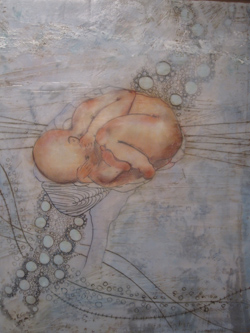While scientific advancement has led to solutions and cures that had previously seemed impossible, it has also bred confusion. In fact, very few average people can grasp the small, intricate details of how things actually work anymore. In the exhibition “What Was There To Be Seen,” on display now at the Ann Loeb Bronfman Gallery on 16th Street near DuPont, Kindra Crick and Carolyn Bernstein convey their personal fascinations and frustrations with the often cumbersome subject of biology.
Paradigm Shift: Bonds and Binds, a collection of paintings by Crick, is the product of an artist with a degree in molecular biology taking to the canvas in attempt to marry science with emotion. Several pieces bear the image of a fetus and reflect Crick’s absorption with life in its rawest, most captivating state. Their combination of bright and faded colors adds an organic feel, which effectively bridges the gap between objective science and beauty. Crick’s infatuation with the heart, both figuratively and literally, comes alive as well in a series drawn in both the typical,Valentine’s Day shape and more realistic depictions of the organ that could be straight from an 18th-century surgeon’s textbook. Although the collection contains some more abstract pieces which are not as conducive to the gallery’s goal, the majority of the paintings in Paradigm Shift poignantly channel a scientist turned artist’s fervor for two disparate yet mutually accommodating worlds.

In stark contrast to Crick’s revelation of the beauty in science, Bernstein’s Yew Tree Project takes aim at the convoluted and political nature of pharmaceuticals, particularly the cancer drug Taxol, which is developed from yew trees. Bernstein’s mediums include glass and clear paper, meant to resemble the tools of a radiologist, and many of her drawings depict human body parts, including several cancer-ridden brains. One work, a chaotic web diagram, narrates the political gridlock associated with developing and distributing Taxol, and contrasts it with the harmonious leaves of a yew tree—a gesture to the drug’s natural roots and the overbearing qualities of its cure.
Bernstein showcases her straight-forwardness on the sensitive subject in her portrait of a human body, which is composed of words that indicate how cancer affects different parts of the body. The simplicity and beauty of the yew tree are manifested in nearly every one of Bernstein’s works, and while the draining qualities of cancer on its patient may only be compounded by the maze of treatments and drugs used to fight it, Bernstein offers clarity by paying homage to the drug’s most basic—and literal—roots.
While they lack the detailed imagery of Crick’s paintings, Bernstein’s less conventional mediums are enthralling in their matter-of-factness. But side-by-side, the two artists share a commonality in that science inspired their artistic creation. Neither science nor art could function without the fuel of human emotion, and “What Was There To Be Seen” reestablishes this link in a beautiful, poignant way.




